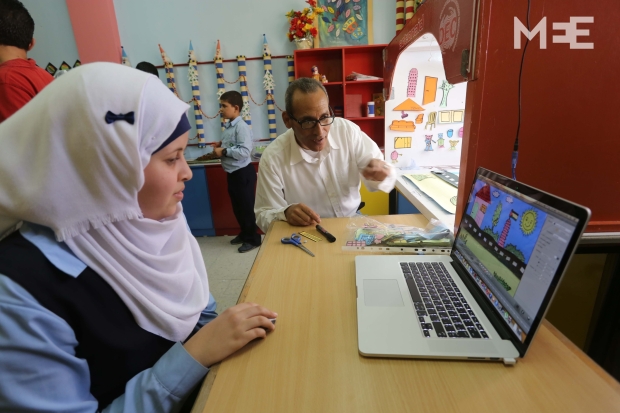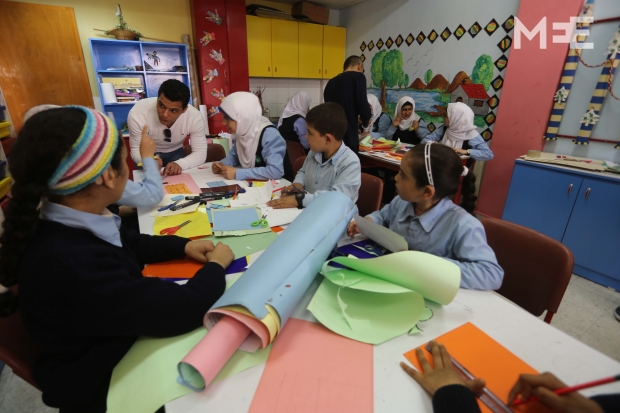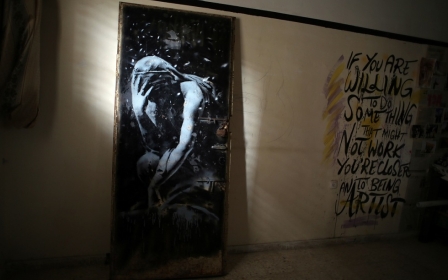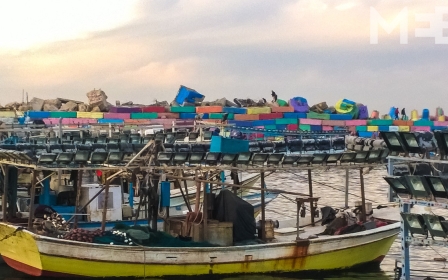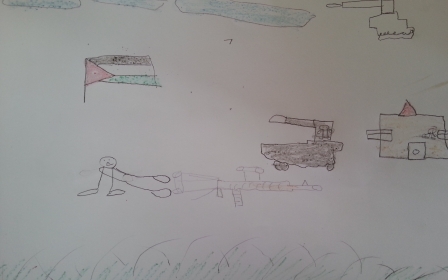Deaf children in Gaza use expressive film to tell their tales

Fourteen year-old Abdullah Ghazal lived through and experienced the 51 day Israeli assault on Gaza last summer in a way that was very different to most other Gazan children his age. Unlike the others he didn’t realise the full extent of the assault until after it was over.
As a deaf child, he was with his family in their tiny Gaza apartment when it all started. Everyone in his family understood that there was an assault going on. The noises of war filled their ears with explosions and screams. The dining table that they all took shelter under shook several times, and the vase sitting atop the table was knocked to the floor. Yet, as Abdullah would later explain, as he could not hear, he could not fully comprehend what was happening - although he knew it was bad. The adults around him tried to comfort him, but he was able to see the abject terror in their eyes and on their faces. All he knew was that something dreadful was happening.
“I was afraid, because I could neither hear the bombing, nor any news, nor what the people around me were shouting and screaming about - I could only feel the physical effects and tremors around us. I only fully realised the outcome of the war, when I came to the institute.”
Upon his return to the Deaf Institute where he learns, he started to ask his teachers many questions, finding out which of his friends were still alive, injured or missing. Walking the streets of Gaza, trying to find missing friends, he was also able to witness the large-scale destruction first-hand.
It was hard for him to express his experiences at first, but now, thanks to a cartoon and silent film project, he and other deaf children have been given a medium to express their feelings and memories. He hopes that this medium will empower Gaza's deaf community to send a powerful and creative message to the world.
“I never knew about filmmaking, but thanks to Allah, I can express the suffering I experienced, through short silent movies and children’s cartoons,” he told MEE with the help of a sign-language interpretor. “I am surprised that the media is focusing on us, but now we’ll be able to address the world through our work."
In Atfaluna, Arabic for "our children," deaf children have turned to images to verbalise their experiences - they have translated their fears into video frames that they hope will reach the outside world. Eleven-year-old Saja Habeeb insists on using a white dove - the universal symbol of peace. She says that she loves art, and finds that it’s the only way she can express her feelings.
Atfaluna Deaf Society coordinates the programme, says the UN-run centre's coordinator, Mandi Sirdah. So far, Atfaluna has produced five films. The animation is not only meant to entertain Aftaluna's students, but it was also intended to provide healing for the children, says Sirdah.
"The mission of this programme is to help the deaf children speak about their suffering."
Every year, the centre teaches 500 students and helps hundreds more within the Gazan community. The idea to start producing films came after the war, when teachers saw new behavioural problems emerge among their students.
The project, part of the Fekra Association, started after students realised that when Israel fires F-16 missiles at a home, a panicking mother has no time to gather all her children. In one of the films produced by Atfaluna's students, the child left behind by his mother is represented by a sheep who is left behind by his mother and is unable to escape with the rest of the flock.
The lost sheep finally manages to escape outside, only to witness pieces of human flesh scattered on the empty streets, with homes burning all around and ambulances trying desperately to find survivors or collect the dead for burial. The sheep wanders around lost and alone - knowing that whatever happens to him, he won’t be picked up by an ambulance.
“Deaf children want to convey their feelings through these two-minute compressed films, to express complex and deep emotions from the conflict," explained Sirdah.
UN and Palestinian officials say that 130,000 homes were destroyed, demolished or damaged, largely by Israeli airstrikes and tank shells during the July-August war in the densely populated, besieged, coastal territory of Gaza.
“The children are encouraged now that the media is coming to ask how these films have been produced,” added Sirdah.
The sense of accomplishment is now seen in the eyes of 12-year-old Wafa Abuel-Mezza, who is creating and designing the sheep who is about to be stranded in the middle of a war zone, not knowing what has happened to the rest of his flock.
Wafa smiled, while colouring the cartoon sheep, and confidently explained the process through sign language: “I am good with art, and am thrilled that my thoughts are now translated through animation. With drawings I try to express my negative energy and all the bad feelings that were trapped inside me for many months after the war,” she said.
This is the first project involving trauma therapy for deaf children in Gaza, a group that has many needs and is often forgotten about or ignored by the rest of the community.
As the teacher passes by to see the children’s work, one girl insists that showing a baby chicken in the cartoon is important, because she knows the lost baby chick feels the same fear that she did.
Saja Habeeb continues to carefully illustrate the facial features of the chick. She hopes to use this character as the narrator, to tell the untold story of Israel’s 51-day assault last summer, an event of which Gaza's deaf community was a forgotten part.
New MEE newsletter: Jerusalem Dispatch
Sign up to get the latest insights and analysis on Israel-Palestine, alongside Turkey Unpacked and other MEE newsletters
Middle East Eye delivers independent and unrivalled coverage and analysis of the Middle East, North Africa and beyond. To learn more about republishing this content and the associated fees, please fill out this form. More about MEE can be found here.


